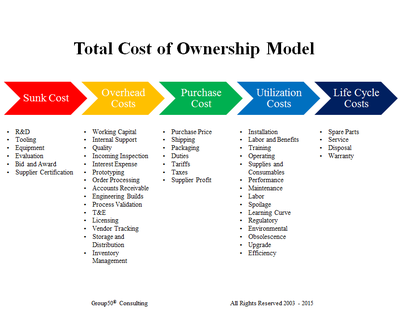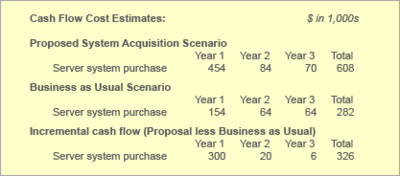Total Cost of Ownership (TCO)
What is Total Cost of Ownership (TCO)?[1]
Total Cost of Ownership (TCO) is a comprehensive assessment of information technology (IT) or other costs across enterprise boundaries over time. For IT, TCO includes hardware and software acquisition, management and support, communications, end-user expenses, and the opportunity cost of downtime, training, and other productivity losses.
Total Cost of Ownership Formula[2]
The TCO Calculator is designed to help people who are new to the concept of the total cost of ownership.
It may not be particularly useful to those who are experienced and/or qualified in accounting or related disciplines - it is recommended that these people continue to use their current methodology, or seek more sophisticated software.
The calculator contains a number of categories and sub-categories of costs associated with the life cycle of an item. Some of these are obvious, like the purchase cost of the item, but some are things that you might not have thought of, such as the cost of outages. The calculator is designed to prompt you to think about costs that you may not have thought of, but you only need to enter data into the fields that apply to the product that you are procuring.
"The TCO Calculator will automatically calculate:
- an overall Total Cost of Ownership
- totals for the various sections, categories and sub-categories, and
- percentages of the TCO for each of the categories."
Click for a Total Cost of Ownership Calculator
Total Cost of Ownership Model[3]
The concept of the Total Cost of Ownership (TCO) is not new and for many not a bit exciting. But, it is a critical part of the acquisition process and has been successfully used for the analysis of Information Technology and government-procured products for many years. It is a mainstay of the Federal Acquisition Regulations (FAR). Yet, the concept of the Total Cost of Ownership hasn’t been universally adopted by middle-market manufacturing and distribution companies as part of their standard Supply Chain Management (SCM) Solutions.
Middle-market companies don’t typically have sophisticated procurement systems and in most cases don’t have the systems and metrics to develop a Total Cost of Ownership model. The purchase price, shipping, and delivery dates are what most buyers are interested in. They might pay attention to a vendor that is particularly bad but doesn’t have the ability to define and measure the nuances of cost. This failure to do so can consume significant amounts of operating profit over the lifecycle of a product or a component. In some cases, the purchase price can be as little as 20% of the Total Cost of Ownership.
Utilizing the Total Cost of Ownership model requires a process that once defined isn’t difficult to maintain. As illustrated in the figure below it consists of 5 primary buckets of cost and their corresponding cost factors.
Total Cost of Ownership Example[4]
The cost model (above) provides the total cost of ownership analyst with a list of cost items—the contents of all the model cells. The analyst must then estimate cost figures for each item, for each scenario under consideration, for each year covered by the analysis
Here, for example, are one analyst's estimates for just one cost item (Server System Purchase):
The TCO analyst must make six cost estimates for one cost item ("Server system purchase") when the TCO study includes two scenarios (Business as Usual and Proposal"), over a three-year ownership life. The three incremental cash flow estimates are then determined automatically as "Proposal Estimate - Business as Usual Estimate" for each year.
Methods for making these estimates are beyond the scope of this encyclopedia entry, but briefly, the analyst will base these figures on several kinds of information. For the IT example, the analyst will forecast cost drivers for each item, under each scenario, (for example, number of users, transaction volume, storage space requirements, and so on). The analyst will also base the estimates on vendor-provided information, experience with similar systems in other settings, and industry standards and guidelines.
With cost categories and cost items from the cost model, the analyst can build the primary analytic tools in the TCO study: cash flow statements for each scenario.
Total Cost of Ownership in Procurement[5]
TCO can be used at various stages in procurement:
- in a business case to assess the costs, benefits, and risks associated with the investment
- when assessing different business models, maintenance options, or solutions on a comparable cost basis
- to understand the different cost drivers in the life of a procurement
- by a supplier when bidding for a contract to demonstrate the total benefits and value being offered – especially where the initial purchase price is higher than competitors, but the total cost of ownership is lower
- in selecting the best supplier by assessing the comparative whole-of-life costs of competing bids
- in managing the contract to track actual expenses and income against budget
- as part of a benefits realization exercise.
See Also
- IT Financial Management (ITFM)
- Technology Business Management (TBM)
- IT Chargeback
- Federal IT Acquisition Reform Act (FITARA)
- IT Cost Allocation
- Total Cost of Risk (TCoR)


